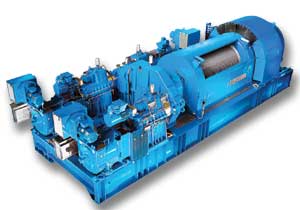| Vol. 227 No. 12 |
 |
Rig floor equipment
Dual-disc braking system offers maximum redundancy, safety
Over the last couple of years, the German company, Wirth GmbH, has field-tested and proven the Dual Brake System (DBS) for use on standard rotary drilling rigs. It is now available for commercial use on a wide scale. The DBS system was developed in cooperation with Svendborg Brakes to achieve the following advantages during emergency braking:
- Limit maximum rope force, independent of load and speed
- Keep deceleration constant
- Adapt the brake torque to load demand
- Provide full redundancy
- Back up the emergency brake system with full performance, even in a power failure situation.
 |
The DBS system offers two fully redundant, independent disc brake systems for maximum drawworks braking and safety.
|
|
The system comprises two independent disc brake systems. Each provides full braking capacity to park the drawworks under normal (static) conditions, or to stop the drawworks under emergency stop conditions, taking over the load immediately from the drives. Each disc brake system is equipped with fail-safe, hydraulically-operated caliper sets that apply braking force through springs. One system is installed directly beside the drum; the other is installed away from the drum, directly on the drive shaft of the main motors.
The DBS is an intelligent, redundant PLC-controlled system that handles speed and load of the drawworks drum and wireline. The system ensures that the entire braking force never exceeds the maximum allowable values limited by the derrick structure or wire-line arrangement. The disc brake system installed beside the drum acts as the master brake, and it is normally in operating mode. Concurrently, the second brake system remains in standby mode.
The system includes redundant controllers, one for each of the systems, adapting brake torque to the correct values. This is based on a digital, closed-loop regulation with speed versus time. A main controller box provides the brake signal to both of the redundant controllers in the master and slave systems. Encoders observed drum speed continuously during the braking process and adapt the force of the brakes with help from “digital pulse width modulation” (DPWM). The benefit of DPWM is that an extremely low flowrate is required to perform the braking cycle. Limited flowrates ensure smooth and safe hydraulic operation of the brakes during a power failure.
The operator is informed about the available braking force of each independent system via the HMI display in real time. On reduction or loss of the master braking force, the second brake will engage to compensate. The DBS thus provides maximum safety, permitting full, continual operation of the drawworks until remedial work can be performed on the master brake. The system has been certified by DNV, as well as ABS, for use on a variety of rigs. 
|




